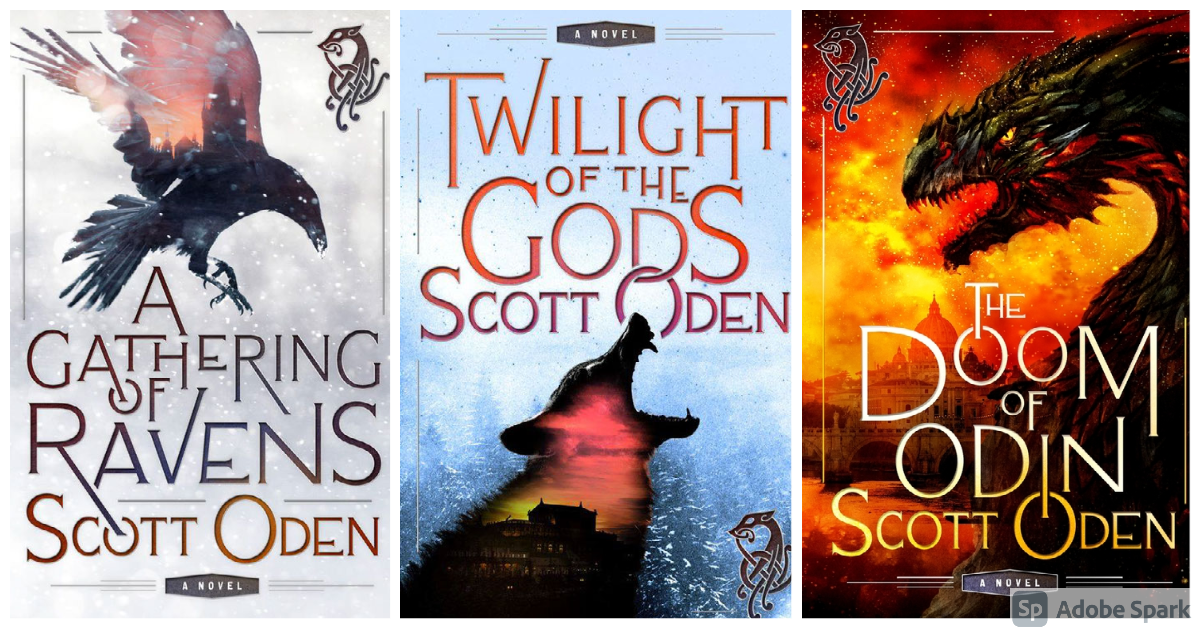Scott Oden is a bestselling author of historical fantasy and sword-and-sorcery. Since his debut in 2005, his books have received starred reviews from Publishers Weekly and Booklist; he has been an Amazon Editor’s Pick and has been nominated for a Gemmell Award. His work has been endorsed by such preeminent authors as Steven Pressfield, David Anthony Durham, and John Gwynne.
Scott lives in the foothills of the Appalachians with his lovely wife, Shannon, and a variety of dogs — all of them neurotic and prone to dancing like no one’s watching.
Before turning his hand to writing, Scott worked the usual slate of odd jobs, from delivering pizza to stocking shelves at a local grocery. In his spare time, he likes table-top roleplaying games, reading, and making the occasional bracelet from old stone beads. He dreams of running away from reality and living in a Hobbit hole . . .
We’re so excited to have Scott on the blog today to discuss his upcoming novel, The Doom of Odin, book three of the Grimnir Saga! He’ll also let us in on what his publishing journey looked like, along with some helpful fantasy writing tips!
Can you tell us a little bit about yourself and your books, including your upcoming novel, The Doom of Odin?
Sure! My name, as you might have guessed, is Scott Oden. I write primarily historical fantasy and the subset of fantasy known as sword-and-sorcery (a sub-genre created in the 1930s by Texan author Robert E. Howard, and made popular by his most famous character, Conan of Cimmeria). I got my start in 2005 with a book called Men of Bronze, which began its life as a pastiche Conan novel, but later became an historical novel in its own right.
Things went well, and life grew by turns easy, then messy, which is how lives were meant to go. When things got really dark, back in 2011, a constant companion was an idea from my childhood, about one of Tolkien’s orcs escaping into the “real” world. And that’s how Grimnir, who is the central figure in his own Saga, was born: a friend dared me to reverse-engineer orcs into Norse myth, set them in the historical past, and make it not reek to the highest heavens.
The Doom of Odin is the culmination of that friendly wager.
So, who is Grimnir? He is the last of his kind, the last of a race of monsters first created by Loki to act as guards for his equally monstrous — and Doom-ridden — children: Fenrir, Jörmungandr, and Hel. They failed, of course, and most were killed by the Norse gods. A few escaped via tricksy ways to Miðgarðr, our world, where they formed the basis for most of the monsters of Northern myth, from Grendel to the Irish Fomorians. By the time the first book, A Gathering of Ravens, begins in 1000 AD, Grimnir is the last surviving member of his species, drawn from hiding to avenge the murder of his brother. This takes him from a cave in Denmark to the battlefields of Clontarf, and we see first-hand a world that is slowly dying as the power of myth is replaced by the power of a new god from the east.
The second book, Twilight of the Gods, picks back up with Grimnir some two hundred years later, about 1218 AD. It chronicles his efforts to preserve a tiny slice of the Elder World, stop a Northern crusade, and derail an ancient prophecy about the resurrection of the dragon, Níðhöggr.
And finally, in The Doom of Odin, Grimnir’s saga comes to a crashing halt as he is slain outside Rome, on a cold night in November, 1347 AD. But death, it seems, only complicates things as he is thrust headlong into an afterlife filled with treacherous kin-folk, eerie witches, trolls, and an array of giants. When he stumbles onto a monstrous secret, though, he realizes he might just be the most powerful player on the board . . .
You love to write about history meeting fantasy (same!). Where do you get the inspiration for tales like The Grimnir Saga?
Historical fantasy is a curious beast. On the one hand, it’s fable given life — all the eerie bits, the bumps in the night, clothed and paraded against the panorama of historical fact. On the other hand, it is factual. It trades on its historical authenticity to give the fantastical a veneer of truth. The magic of historical fantasy exists in the interstices, in the shadows, in what’s not said upon the printed historical page. We writers must tease the sorcery from that.
Grimnir’s inspiration runs the gamut. His DNA is a mix of pulp adventure, especially Robert E. Howard, and the “Northern Thing” of JRR Tolkien. In temperament, he is equal parts Shagrat and Gorbag from The Lord of the Rings, REH’s Conan of Cimmeria, a touch of Fraser’s Flashman, a pinch of Bernard Cornwell’s Uhtred of Bebbanburg, and all of it wrapped in a snarling, spitting package of hate, blasphemy, and gallow’s humor. Grimnir will lie, cheat, steal, or kill to get his way. He’s not conflicted by any of this; he’s not ridden by pangs of guilt. By any other metric, he’s an evil SOB with psychopathic tendencies, terminal narcissism, and an utter disregard for human life. But . . . But, he’s also a creature of his word. Once an oath is given — or extracted from him — he will move mountains to see it done. And when he has a friend, he’ll kill more enemies than the plague to keep that friend safe.
As for his adventures, I look for those little-used corners of history: the run up to the Battle of Clontarf in A Gathering of Ravens; the Northern Crusades in Twilight of the Gods, and the advent of the Black Plague in The Doom of Odin.
What does your research process look like when you’re writing a book?
Chaotic is probably the best descriptor. I like to start with primary source material, then shore that up with an encyclopedia or dictionary relating to the topic at hand. Secondary sources come next. Then, if need be, I’ll hop online and brave the wilds of Wikipedia. I’ll add little research notes to the (very) detailed synopsis I write before I begin my initial draft. That way, I know where the knots are that might require a moment to untangle.
My thought is, I need to know what actually happened, or near to it, before I start to monkey with the underpinnings of history. So, I’ll cast my net rather broadly: social histories, food and drink, clothing, histories of trade, weapons and warfare. The process of building my story world is akin to art forgery. I start with a blank canvas. I want this canvas to look just like the 11th century, for example, so I start gathering works of 11th century art, copying themes and details, but adding my own creations where lacunae exist. If I do it right, it should look like an 11th century masterpiece.
What did your journey to publication look like?
It started Way Back When, before the Internet and email, before Google and Amazon, before self-publishing was a viable and acceptable alternative. When I could, I bought the newest edition of the Writer’s Market and used it to find editors and addresses, then snail-mailed Xeroxed manuscripts of short stories, or queries and synopses when I finally had a book-length manuscript to sell. I started Men of Bronze in the early 1990s, as a Conan pastiche novel. By the Millennium, it was its own thing — an adventure novel set in the 26th dynasty of ancient Egypt. That version was completed in 2002; seventy-nine rejections later, I had my first agent, who then sold it to a new independent publisher called Medallion Press (now defunct). It came out in 2005, at Book Expo in NYC. I shifted to Thomas Dunne Books/St. Martin’s Press in 2008, and I’ve been there ever since.
Honestly? The early 00’s was the last time I had to bother with queries and rejections. I’ve sold everything since then based on previous interactions with editors. I think I’m one of the rare few writers who isn’t sitting on a trunk novel or three. I’ve been lucky in that I’ve sold everything I’ve ever proposed.
What’s funny, though, is even as I write the words above, I realize I’m at the end of my contract with St. Martin’s, and after The Doom of Odin I’ll be at the mercy of the Wild Publisher Hunt, once again. Sobering and not a little scary . . .
Your author bio says you don’t enjoy “hard” magic systems. Since most advice for creating a magic system revolves around implementing rules, what does your process for creating a magic system look like?
By its very nature, magic has no rules. It needs no rules. Magic is the force which upends the rules of the Universe, which makes a mockery of the natural laws. Giving it rules and power levels and explanations for how it works just smacks, to me, of gaming. If this be your thing, then go with the gods and more power to you. It is not my thing.
What I did in the Grimnir Saga was to answer one very simple question, first: is magic real? Yes, it’s real; it works, though not always in the way it’s intended. That led to the second question: how does it work? To answer that, I studied historical magic among the Old Norse and developed my answer. In Grimnir’s world, most magic is from the gods, perhaps a boon of wisdom, a gift of foresight, a taste of prophecy. The rest is done via a system of give and take between the spirits of the Unseen world and mortal sorcerers. Grimnir is part of that Unseen world, already, yet he largely lacks the wisdom to take advantage of his place in the Universe. Even so, his mother was a feared sorceress among their people, and her brother — Grimnir’s maternal uncle, who raised him — was as wise as he was cunning. So, he has the foundations for sorcery, at least.
The sorcery Grimnir does practice (which came about because I’d written myself into a corner, and it was easier to expand upon a few hints I’d left behind than try to noodle my way out of this corner) is transactional: “I’ll give you this if you give me that!” It is the memory of forgotten lore, the power of chanted verse. It is blood for blood. There’s no flashy combat magic. No fireballs or magic missiles. There is only ritual, poetry, oaths, and offerings. And none of it is constricted by rules. Grimnir could tear down a city wall and slaughter half the inhabitants within, provided he could find a potent enough spirit and strike a bargain with it. He could travel among the Nine Worlds of Norse myth, so long as he knew the words that would open the gates. Given enough blood and enough wisdom, Grimnir could even raise the dead . . .
What is the best piece of writing or publishing advice you’ve ever received?
Finish what you start. This comes courtesy of Lawrence Block, from his excellent book, Telling Lies for Fun and Profit. I spent my early career writing half a manuscript here, a quarter of a story there. Then, Block’s book took me to task. Under its tutelage, I refused to let myself start another thing until I’d finished what was already on my plate, for good or ill. It was torture, but by the end, I had a useless manuscript for a short story and a better understanding of how a writer really needs to be picky about what they start. This advice has stood me in good stead for many years now.
Can you provide links to any social channels you’d like readers to follow?
Follow my blog for updates as to what I’m working on, or find me on Substack for more essay-style shenanigans.
Blog: https://scottoden.wordpress.com/blog/
Substack: https://soden.substack.com/

For more author interviews with writing and publishing advice, click here.
To sign up for Ready Chapter 1’s Peer Critique Forum to get fast, actionable feedback on your writing, click here.




